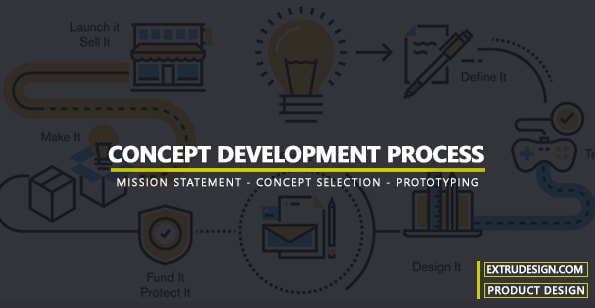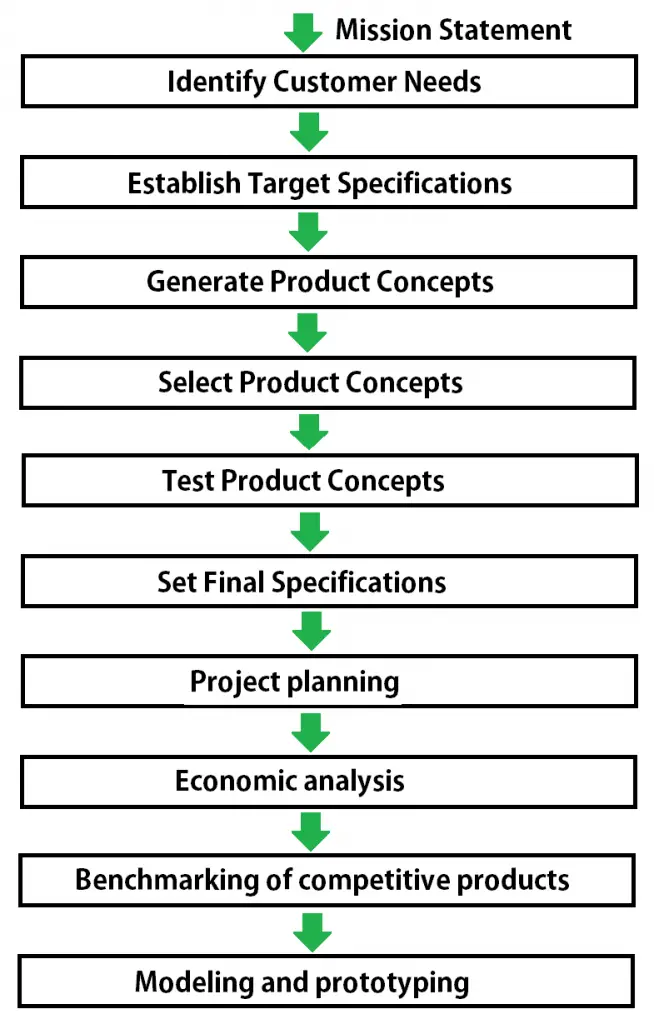As we have already discussed what are the different Product development processes, the concept development process is the front-end process of all the other product development processes. Now we will discuss the Concept Development process in detail.

Concept Development Process
As we said above the concept development process is the front-end process. It requires more coordination among the functions than any other product development process.
See the following schematic tree diagram representing all the different phases in this front-end process.

- Identifying customer needs
- Establishing the target specifications
- Generate Product Concepts
- Select Product Concepts
- Test Product Concepts
- Set Final Specifications
- Project planning
- Economic analysis
- Benchmarking of competitive products
- Modelling and prototyping
The concept development process includes all the above-mentioned activities.
All these activities will be completed one by one and proceed by another or can be overlapped. Any of the activities can be repeated before proceeding with the next activity called the development iteration.
Identifying customer needs
The main objective of this activity is to understand customer needs and effectively communicate them to the development team. In this activity, the customer statements will be defined, prioritized by importance, and organized in a hierarchical list.
Establishing the target specifications
Specification means the precise description of what a product has to do. As we mentioned in the above activity, the customer needs, these customer needs will be the input for defining and establishing the target specifications for the product.
Later on, these specifications will be refined further based on other activities’ information and analytical data. The output of this stage is a list of the specifications.
Generate Product Concepts
As we have already set the product specifications, we have to explore the available product concepts and that can help to address the customer needs, or creative problem solving, and systematic exploration of the various solution fragments generated by the team also helps to create a number of concepts that actually can address most of the customer needs and problems.
The output of this stage will set usually multiple concepts ranging from 10 to 15 concepts. All of these concepts would be described with the schematic sketch and the description of what it exactly would do.
Select Product Concepts
As we have multiple numbers of concepts in hand, we need to identify which one is the most efficient product concept which will address most of the customer’s problems meets the customer’s needs. So basically we will eliminate the product concepts by analyzing and sticking to the most promising concepts.
We did mention that about the development iteration, this concept selection will be used to have many iterations during the selection process. The output of this stage is one or multiple numbers of concepts that will be selected to test.
Test Product Concepts
We have to test the selected concepts before we proceed with setting the final specifications for the product based on the selected product concept. This test is necessary to validate whether the product going to address the customer’s problems and the meeting the customer’s needs.
Also, we need to assess the market potential for the product, if the customer response is poor, most of the cases the project will be terminated, or the earlier activities such as the concept generation, the concept selection will be repeated to get the better response from the customer in this stage.
Setting Final Specifications
We have already set some product specifications in the earlier activities, those will be further refined as we said earlier. These refinements and amendments will be done according to the product selections, technical modeling limitations, trade-offs between the product cost and product performance.
Project planning
This will be the final step of the concept development stage. In this stage, the development team will create a detailed schedule for product development.
This project planning includes development schedule, resource planning, strategy to minimize the development time, budget, agreements between the team and the senior management of the enterprise.
Economic analysis
The team, often with the support of a financial analyst, builds an economic model for the new product. This model is used to justify the continuation of the overall development program and to resolve specific trade-offs between, for example, development costs and manufacturing costs. Economic analysis is shown as one of the ongoing activities in the concept development phase. An early economic analysis will almost always be performed before the project even begins, and this analysis is updated as more information becomes available.
Benchmarking of competitive products
An understanding of competitive products is critical to the successful positioning of a new product and can provide a rich source of ideas for the product and production process design. Competitive benchmarking is performed in support of many of the front-end activities.
Modelling and prototyping
A prototype is necessary for the concept development phase to be shown to the customers, to evaluate ergonomics, style, and technical trade-off. Every stage of the concept development will have these models and prototypes.
These are the different stages, activities involved in the concept development process.
Conclusion
We have discussed the different activities in the product concept development process such as identifying the customer needs, concept development, selection, setting specifications, project planning, prototyping. If you have any further thoughts on this topic, let us know in the comment section below.

Leave a Reply